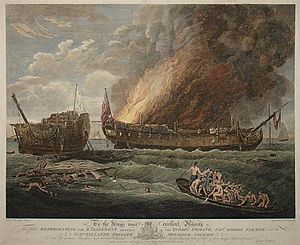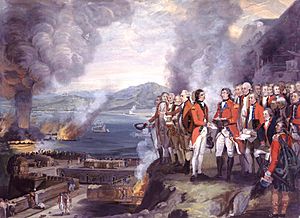George Carter (artist) facts for kids
George Carter (1737–1794) was an English artist. He called himself a "historical portrait painter." This means he painted important events and people. He traveled to Italy with another famous artist, John Singleton Copley, who greatly influenced his work. Carter also spent some time in India.
Contents
Early Life and Artistic Journey
George Carter was born in Colchester, England. He was baptized on April 10, 1737. His parents were George and Elizabeth Carter. He went to the free school in Colchester. Later, he moved to London. There, he first worked as a servant. Then, he worked for a mercer, someone who sells fabrics.
Carter later started his own fabric business in Covent Garden. However, his business did not do well. After this, Carter decided to become a painter.
Travels and Influences
In 1774, Carter visited France and Italy. He traveled with John Singleton Copley, an American artist who had just arrived in England. Copley first described Carter as a "very polite and sensible man." He also said Carter had "seen much of the world."
However, their friendship became difficult during the trip. Copley later made a negative comparison about Carter. Despite this, Copley's style greatly influenced Carter's art. Carter's paintings of big events, like the death of Captain James Cook, showed this influence.
An art expert named Frederick Peter Seguier noticed something interesting. He saw a "slight resemblance" between Carter's paintings of the Siege of Gibraltar and some historical pictures by another artist, Zoffany. Seguier also said that Carter's figures, when viewed as portraits, were "very good." Carter even visited Gibraltar in August 1784. He went there to paint the British officers who were part of the battle.
Exhibitions and Famous Works
George Carter showed his paintings at the Royal Academy in London. He exhibited there between 1775 and 1784. In 1775, his address was listed as "at Rome." In 1776, it was 21 Goodge Street. After that, it was Margaret Street, Cavendish Square.
Some of his notable paintings included:
- A Weary Pilgrim on his Journey to St. Peter
- The Dying Pilgrim, with a View of the Sybil's Temple at Rome
- Philosophers Reasoning in Ovid's Tomb (1776)
- The Meeting of Isaac and Rebecca (1777)
- The Adoration of the Shepherds (1778) – This was an altarpiece for St. James's Church in Colchester.
- The Immortality of Garrick, with Portraits of the Principal Actors (1784) – This painting is also known as The Apotheosis of Garrick. It is now owned by the Royal Shakespeare Company. The painting shows a famous actor, David Garrick, being carried by angels. A crowd of leading actors of the time watches this scene. The writer Horace Walpole described this painting as "ridiculous and bad." An engraving of the picture was made, which helped people identify the individuals shown.
In 1786, Carter held his own art show. He displayed 35 of his paintings in Pall Mall.
Time in India and Later Life
George Carter also spent some time in India. On his journey there, he met a man named John Hynes. Hynes was a survivor of a terrible shipwreck. In 1791, Carter published Hynes's story. The book was called A Narrative of the Loss of the Grosvenor, Eastindiaman. Carter also included his own engravings in the book. On the title page, he proudly called himself "George Carter, Historical Portrait Painter."
Later in his life, Carter lived in Hendon. He passed away there on September 12, 1794.



